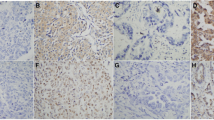Abstract
Krüppel-like factor 8 (KLF8) plays a key role in cancer progression. However, its expression pattern and relationship with clinicopathological characteristics in non-small cell lung cancer (NSCLC) has not been completely elucidated. The study aimed to investigate the expression of KLF8 and its correlation with clinical pathologic features in NSCLC and to explore the potential mechanism. The expression of KLF8 in NSCLC was detected by RT-PCR, Western blot and immunohistochemistry. The expression of Vimentin and E-cadherin, epithelial-mesenchymal transition (EMT) markers, were detected by immunohistochemistry in the NSCLC. The relationship between KLF8 expression and various clinicopathological features or EMT markers was investigated. The results showed m-RNA and protein of KLF8 were overexpressed in NSCLC and the percent of KLF8 positive cells was positively correlated with TNM stage, lymph node metastasis and poor overall survive. Moreover, high expression of KLF8 correlated with E-cadherin low expression, and Vimentin overexpression. Additionally, COX multivariate regression analysis suggested that TNM stage, KLF8, E-cadherin and Vimentin were independent prognostic indicators for overall survival of patients with NSCLC. The data demonstrate that KLF8 is overexpressed in NSCLC. KLF8 overexpression promotes the malignancy of NSCLC, which mechanism may be involved in EMT. KLF8 maybe serve as a potential therapeutic target for NSCLC.




Similar content being viewed by others

References
Jemal A et al (2011) Global cancer statistics. CA Cancer J Clin 61(2):69–90
Siegel R, Naishadham D, Jemal A (2012) Cancer statistics. CA Cancer J Clin 62(1):10–29
Gao W et al (2011) Circulating microRNAs: possible prediction biomarkers for personalized therapy of non-small-cell lung carcinoma. Clin Lung Cancer 12(1):14–17
Smith CB, Kelley AS, Meier DE (2010) Evidence for new standard of care in non-small cell lung cancer patients. Semin Thorac Cardiovasc Surg 22(3):193–194
Pearson R et al (2008) Kruppel-like transcription factors: a functional family. Int J Biochem Cell Biol 40(10):1996–2001
Zhao J et al (2003) Identification of transcription factor KLF8 as a downstream target of focal adhesion kinase in its regulation of cyclin D1 and cell cycle progression. Mol Cell 11(6):1503–1515
Wang X, Zhao J (2007) KLF8 transcription factor participates in oncogenic transformation. Oncogene 26(3):456–461
Quadrini KJ, Bieker JJ (2002) Kruppel-like zinc fingers bind to nuclear import proteins and are required for efficient nuclear localization of erythroid Kruppel-like factor. J Biol Chem 277(35):32243–32252
van Vliet J, Turner J, Crossley M (2000) Human Kruppel-like factor 8: a CACCC-box binding protein that associates with CtBP and represses transcription. Nucleic Acids Res 28(9):1955–1962
Wang X et al (2007) Kruppel-like factor 8 induces epithelial to mesenchymal transition and epithelial cell invasion. Cancer Res 67(15):7184–7193
Wang X et al (2008) Activation of KLF8 transcription by focal adhesion kinase in human ovarian epithelial and cancer cells. J Biol Chem 283(20):13934–13942
Wang X et al (2011) KLF8 promotes human breast cancer cell invasion and metastasis by transcriptional activation of MMP9. Oncogene 30(16):1901–1911
Fu WJ et al (2010) Small interference RNA targeting Kruppel-like factor 8 inhibits the renal carcinoma 786-0 cells growth in vitro and in vivo. J Cancer Res Clin Oncol 136(8):1255–1265
Yang T et al (2012) Kruppel-like factor 8 is a new Wnt/beta-catenin signaling target gene and regulator in hepatocellular carcinoma. PLoS One 7(6):e39668
Li JC et al (2010) Up-regulation of Kruppel-like factor 8 promotes tumor invasion and indicates poor prognosis for hepatocellular carcinoma. Gastroenterology 139(6):2146–2157 e12
Liu L et al (2012) Lentivirus-delivered Kruppel-like factor 8 small interfering RNA inhibits gastric cancer cell growth in vitro and in vivo. Tumour Biol 33(1):53–61
Wang WF et al (2013) Kruppel-like factor 8 overexpression is correlated with angiogenesis and poor prognosis in gastric cancer. World J Gastroenterol 19(27):4309–4315
Thiery JP (2002) Epithelial-mesenchymal transitions in tumour progression. Nat Rev Cancer 2(6):442–454
Iwatsuki M et al (2010) Epithelial-mesenchymal transition in cancer development and its clinical significance. Cancer Sci 101(2):293–299
Thiery JP et al (2009) Epithelial-mesenchymal transitions in development and disease. Cell 139(5):871–890
Goldstraw P (2009) The 7th Edition of TNM in Lung Cancer: what now? J Thorac Oncol 4(6):671–673
Tischler V et al (2011) L1CAM protein expression is associated with poor prognosis in non-small cell lung cancer. Mol Cancer 10:127
Tamura M et al (2005) Prognostic significance of dysadherin expression in patients with non-small cell lung cancer. J Thorac Cardiovasc Surg 130(3):740–745
Maeda J et al (2008) Proteomic analysis of stage I primary lung adenocarcinoma aimed at individualisation of postoperative therapy. Br J Cancer 98(3):596–603
Richardson F et al (2012) The evaluation of E-Cadherin and vimentin as biomarkers of clinical outcomes among patients with non-small cell lung cancer treated with erlotinib as second- or third-line therapy. Anticancer Res 32(2):537–552
Chikaishi Y, Uramoto H, Tanaka F (2011) The EMT status in the primary tumor does not predict postoperative recurrence or disease-free survival in lung adenocarcinoma. Anticancer Res 31(12):4451–4456
Soltermann A et al (2008) Prognostic significance of epithelial-mesenchymal and mesenchymal-epithelial transition protein expression in non-small cell lung cancer. Clin Cancer Res 14(22):7430–7437
Author information
Authors and Affiliations
Corresponding authors
Ethics declarations
Conflict of Interest
None.
Rights and permissions
About this article
Cite this article
Li, J., Liu, Y., Xue, J. et al. Krüppel-Like Factor 8 Overexpression Correlates with Poor Prognosis in Non-Small Cell Lung Cancer. Pathol. Oncol. Res. 25, 115–121 (2019). https://doi.org/10.1007/s12253-017-0321-4
Received:
Accepted:
Published:
Issue Date:
DOI: https://doi.org/10.1007/s12253-017-0321-4



